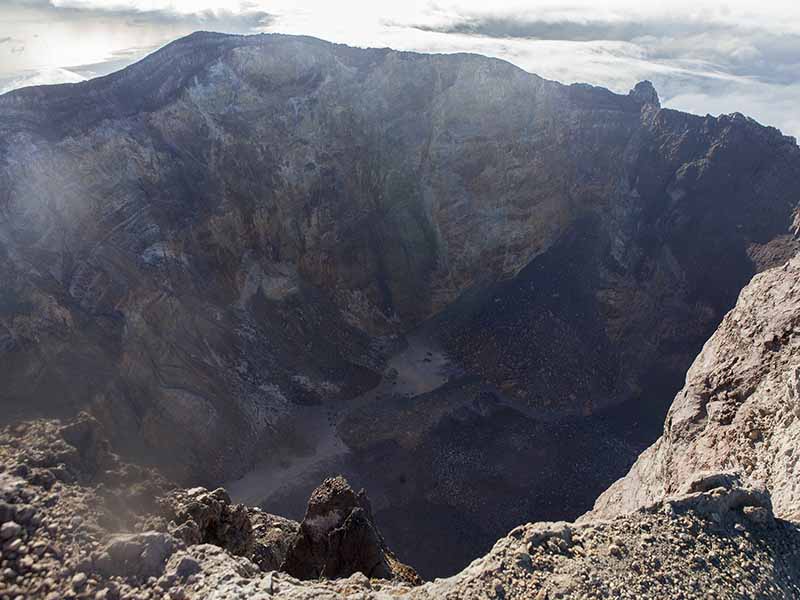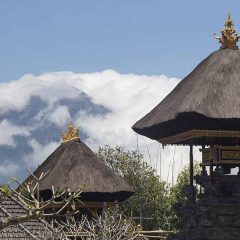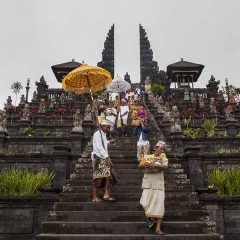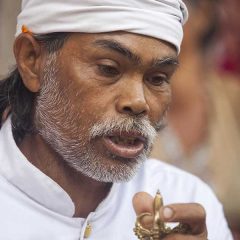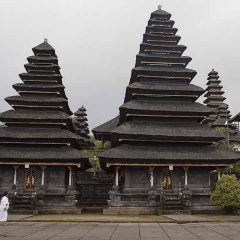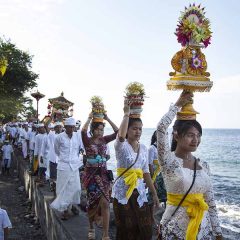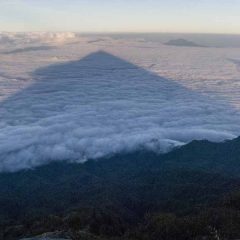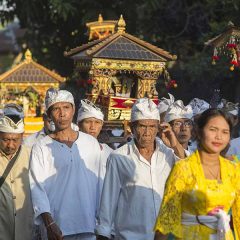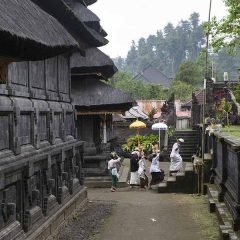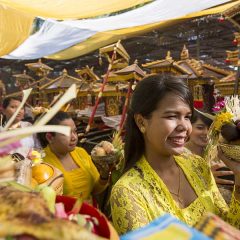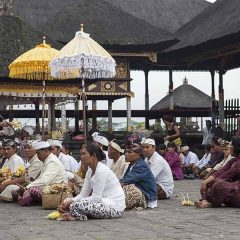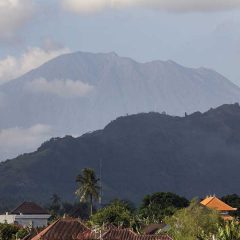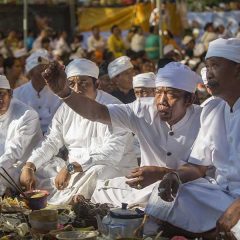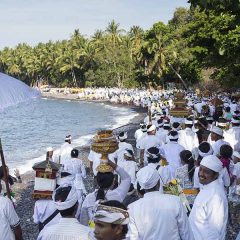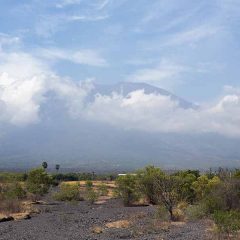BALI, Indonesia (RNS) — For the first time in 54 years, a volcano is about to erupt on Bali.
Balinese Hindus hold sacred the four volcanic mountains that form Bali’s backbone. They believe that Agung, Batur, Abang and Batukaru are home to the gods and that Mount Agung, the highest of the four mountains at 10,308 feet, is the most sacred.
It is also the one poised to erupt.
More than 140,000 people have been living in temporary shelters provided by the Indonesian government in cooperation with local nonprofits since Sept. 23, when the Indonesian Volcanology and Geological Disaster Mitigation Center raised the alert status to its maximum level.
- Mount Agung, a volcano on the brink of eruption, in the background of a temple in Bali. The surrounding areas are on high alert, and more than 140,000 people have been evacuated from the villages on its slopes. RNS photo by Alexandra Radu
- A Balinese procession exits the Pura Besakih temple after a ceremony. The temple complex’s main temple is dedicated to Shiva, one of the three main gods of Hinduism, who adherents believe dwells on Mount Agung. RNS photo by Alexandra Radu
- A Balinese priest chants during a prayer ceremony. Balinese Hindus believe in the duality of good and evil, and creation and destruction. Through ceremonies and offerings both to gods and demons, believers try to maintain a balance between these forces. RNS photo by Alexandra Radu
- A Balinese woman in the courtyard of Pura Besakih, the holiest Hindu temple in Bali. The temple complex, on the slope of Mount Agung, survived the last eruption of the volcano in 1963, when lava flowed within yards of the temple. RNS photo by Alexandra Radu
- Balinese women carry offerings during a procession. RNS photo by Alexandra Radu
- The shadow of Mount Agung at sunrise. Holding a central position in Balinese mythology, the volcano is believed to be the home of gods. RNS photo by Alexandra Radu
- Balinese Hindus take part in a procession. RNS photo by Alexandra Radu
- A Balinese family enters the Pura Besakih temple to give offerings. Ceremonies held throughout the year at the temple complex honor the patron gods of each of the temples and mark full moons and other occasions. RNS photo by Alexandra Radu
- Balinese at a temple ceremony bring offerings to both gods and demons. The offerings for gods are elaborate, with food and rice cookies placed in intricately carved palm leaf baskets. The offerings for demons are more simple. RNS photo by Alexandra Radu
- Balinese Hindu followers attend a ceremony at the Pura Besakih temple complex, the “Mother Temple” of Bali, bringing offerings to the temple gods. RNS photo by Alexandra Radu
- Mount Agung in the background of a Balinese village. The volcano is threatening to erupt for the first time in 54 years. RNS photo by Alexandra Radu
- A Balinese priest chants during a temple ceremony. It is believed that during such ceremonies, the gods descend from the mountain and take part in the celebrations along with the villagers. RNS photo by Alexandra Radu
- Thousands of Balinese take part in Mekiyis, a yearly ceremony in which the shrines of gods are taken from the temple to the sea for purification. RNS photo by Alexandra Radu
- Offerings for gods are lined up along a fence at a Balinese temple. The offerings are made both for gods and for demons. The ones for gods are elaborate and set on higher ground, while the offerings for demons are more simple and are usually set on the ground. RNS photo by Alexandra Radu
- Mount Agung is expected to erupt at any time. The Indonesian Volcanology and Geological Disaster Mitigation Center continuously monitors the situation, while Balinese people pray and give offerings hoping for the mercy of the gods on the mountain. RNS photo by Alexandra Radu
Though Indonesia has more Muslims than any nation in the world, its island province of Bali is mostly Hindu, practicing a form of Hinduism that incorporates elements of Buddhism and animism.
Mount Agung (translated as “The Great Mountain”) is believed to be the home of Mahadeva, the supreme manifestation of the deity Shiva. Legend has it that the mountain was formed when the Hindu god Pashupati split Mount Meru, the Hindu axis of the universe, and created Mount Agung from a fragment.
Often dubbed as “the island of a thousand temples,” Bali has more than 10,000 of them.
[ad number=“1”]
Pura Besakih, known as the “Mother Temple,” is considered the most important. It is a complex of 23 temples located more than 3,000 feet high on the slopes of Mount Agung. Believed to date back to the 10th century, it has been devoted from its founding to Naga Besukianm or “Shiva’s snake,” the dragon god inhabiting Mount Agung.
Locals see a strong bond between Pura Besakih and the volcano, manifested by three sacred holes — one of which is thought to be connected directly to the crater of Mount Agung.
“These holes were not made by people but by the divine will. With the help of these three holes the pressure of the eruption can dissipate and the mountain will not erupt violently but slow and with a low pressure,” said Dewa Ketut Soma, a Pura Besakih priest.
[ad number=“2”]
During Mount Agung’s last eruptions — in the early 1960s, when 1,500 people died — the lava flows came within yards of Pura Besakih. Many Balinese understood this near miss as mercy from the gods, who wanted to show their power but did not want to destroy the holiest of the Balinese worship places.
Although Pura Besakih is within the 7-mile evacuation zone set around the volcano by the Indonesian government, a few priests still carry on prayer ceremonies and make offerings in the temple complex.
[ad number=“3”]
“We are doing rituals to pray for safety and avoid a disaster,” said Dewa Ketut Soma. “If the Balinese sincerely pray in their ritual, then Mount Agung will not erupt terribly but with a mild pressure. But if the Balinese ignore the laws of nature, then Mount Agung will be furious and can erupt causing a terrible catastrophe.”
